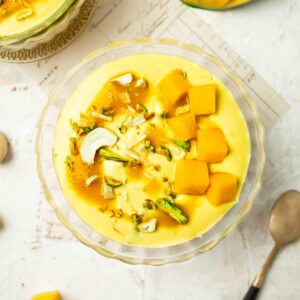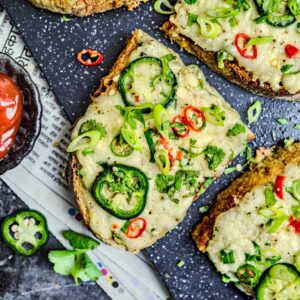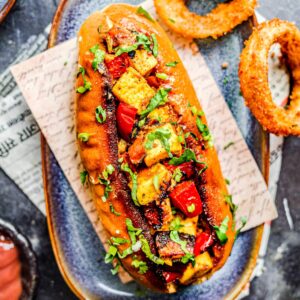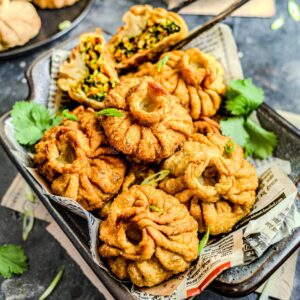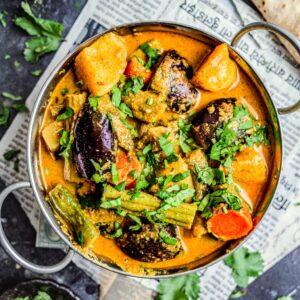Gavar Bhaji (Gawar Phali)
This Maharashtrian gavar bhaji — a dry curry preparation made from fresh cluster beans, coconut, peanuts, jaggery, and a plethora of spices — is characterised by a delicate balance of spicy, sour, and sweet flavour notes. It’s bold, bright, and bountiful!

Recently, I treated myself to a banana leaf thali at a local Maharashtrian restaurant. The thali was loaded with some of my all-time favourite dishes, so it was a massive surprise that my favourite dish was gavar bhaji.
While it wasn’t my first time tasting (or even cooking) gavar bhaji, I’ve tended to overlook it compared to dishes like bhindi masala or flower batata rassa.
It’s a humble, homely dish. You likely won’t see gavar bhaji highlighted on restaurant menus or street food stalls. But that doesn’t mean it’s not worth your time.
Contray — gavar bhaji (gavarichi bhaji, gawar ki sabji, or cluster beans curry) deserves more fans. It’s tangy, subtly sweet, and packed with fresh flavours archetypal of Maharashtrian cuisine.
Plus, this gavar bhaji recipe is quick and easy, especially considering how healthy and versatile the dish is. It’s ideal if you’re looking for a side dish to accompany your varan bhaat that’s a pleasant change from your typical rassa bhaji. Shall we get into it?

🥜 Ingredient Notes for Gawar Sabji
Making Maharashtrian-style gavarichi bhaji requires a handful of everyday spices, some fresh herbs and vegetables, plus a few unique ingredients that bring the quintessentially robust Marathi flavour to our dish.
Although it may appear to be a big list (there are less than 15 ingredients, including individual spices), the layered depth of flavour speaks for itself.
- Gavar (cluster beans in English, also spelt “gawar” or “guar” in Hindi) are the primary ingredient for this gawar sabji. They boast a taste reminiscent of broad beans; subtly bitter and gloriously fresh.
- Neutral oil helps the flavours of all the delicious spices we’ll use infuse throughout the dish.
- Gram flour (chickpea flour/besan) thickens the spice mixture, helping it to stick to the gavar. It also adds a complementary nutty flavour.
- Aromatics such as onion and garlic add natural sweetness and buttery flavour. They both pair exceptionally well with cluster beans.
- Coconut adds a touch of sweetness and tropical flair.
- Spices such as mustard seeds, asafoetida, turmeric, red chilli powder, and coriander powder each contribute a unique depth of flavour: punchy, fiery, fruity, earthy, and garlicky. Goda masala is a finishing spice mix unique to Maharashtra with a beautifully sweet aroma and smoky flavour. It’s essential to elevate your dish. If you can’t access the regional blend, use garam masala.
- Peanuts bring an earthy, nutty flavour and great texture to the gavar bhaji. I prefer to buy raw peanuts and then roast them at home, but you can buy pre-roasted. Just be aware that if they’re salted, you’ll need to add significantly less sodium.
- Jaggery grated into the gawar sabji balances out the intensely fiery spice, and builds depth of flavour with its deep, caramelized flavour.
- Water is needed to cook the cluster beans — it all gets soaked up!
Can You Use Frozen Gavar (Cluster Beans)?
No, I don’t recommend using frozen gavar.
I’ve used them myself and noticed a vast difference in quality. The frozen cluster beans were bruised, stringy, roughly cut, and full of black marks.
In contrast, the fresh cluster beans were a lovely green with no discolouration or marks. It’s important to choose tender cluster beans, which you can tell by their appearance: the seeds shouldn’t be too visible.
Of course, not everyone has access to fresh cluster beans. If you have an Indian store near you, chances are you’ll be able to find them in stock — otherwise, you’ll have to resort to frozen beans.

🤧 Allergy Information
This gavar bhaji recipe is 100% gluten free, dairy free, vegan, and soy free.
Plus, although the recipe isn’t nut free as written, it’s very easily adaptable. Leave out the ground peanuts or replace Luckily, the gram flour adds a nutty flavour without actually including nuts.
Overall, gawar sabji is a healthy meal that’s suitable for almost every dietary requirement, with little to no effort involved. I call that a win!
🔄 Variations
I’m going to toot my own horn — this cluster bean curry recipe is pretty much perfect as-is.
However, throughout recipe testing, I’ve tried a few delicious variations of the base recipe. Once you’ve made the dish as written, you can bring some unique experimentation to the dinner table with these suggestions:
- Bulk out the dish by adding finely sliced potatoes. With this simple addition, you can transform gavar bhaji into a hearty main dish, rather than a side.
- Add a note of sourness with dry mango powder or tamarind juice.
- Switch up the spice level by using less red chilli powder or swapping it out for the highly flavoursome yet less spicy Kashmiri chilli powder.
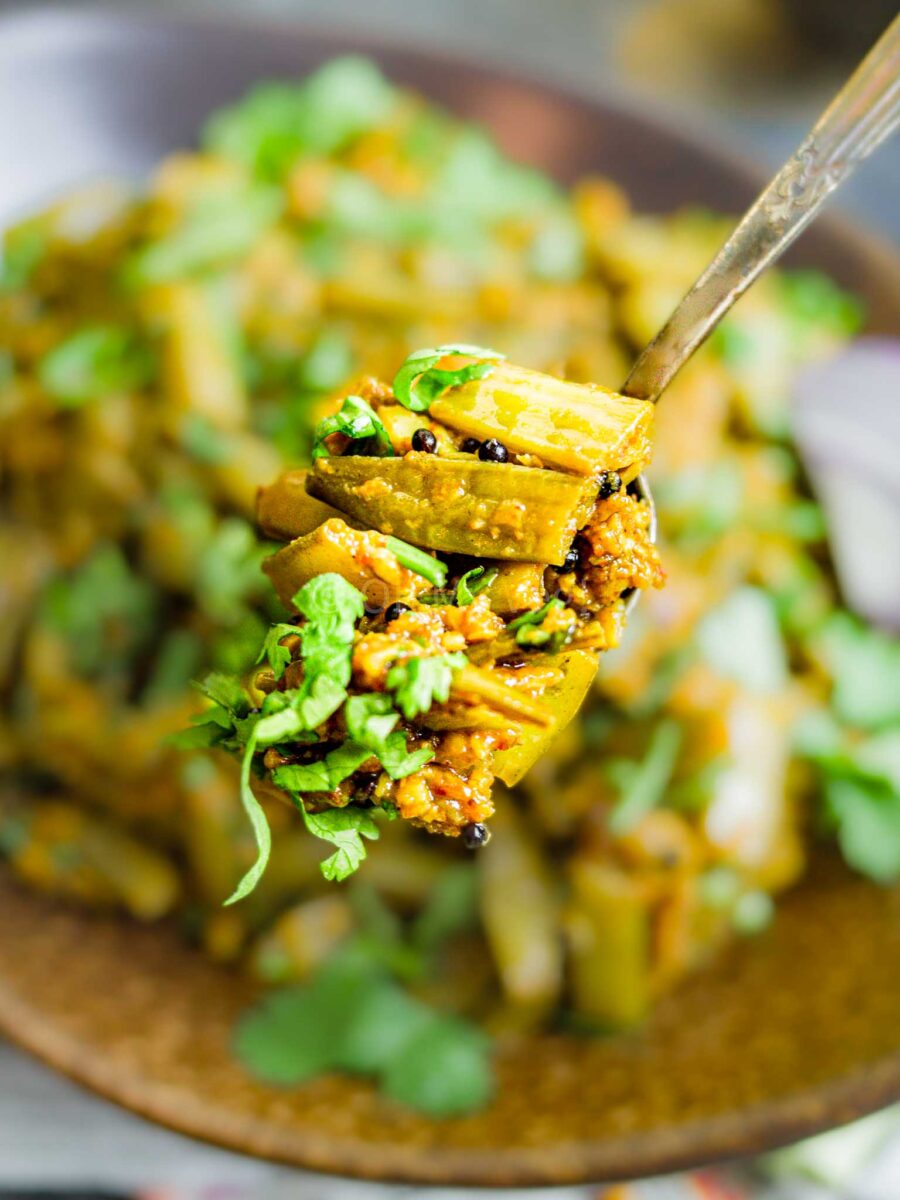
🧑🍳 How to Make Gavar Bhaji, Step-by-Step Recipe
If you’re familiar with cooking Indian curry recipes, the process of making this gavar bhaji recipe will be easy-peasy, as it follows the same fundamental principles.
Nonetheless, I always recommend reading an overview of the recipe so that when the time comes to cook, you’re more confident.
That’s why I’ve highlighted the basic step-by-step instructions here, while including more detailed directions in the recipe card below.
- Fry the whole spices by heating oil in a large kadai, then crackling the mustard seeds.
- Add the aromatics including chopped onion, minced garlic, and a pinch of asafoetida (hing). Saute until soft and fragrant.
- Fry the ground spices, including red chilli powder, coriander powder, and turmeric powder, and be careful not to burn them.
- Add the chopped gavar and mix well.
- Add gram flour, coconut, and ground peanuts Let the mixture toast for a few minutes, stirring regularly, until aromatic.
- Add water and simmer for around 20 minutes, or until the gavar is cooked and has absorbed all the water.
- Season with goda masala, jaggery, and freshly chopped coriander (cilantro).
🪄 Cooking Tips
- Cut the gawar phali uniformly to ensure they cook evenly. In the photos included in this post I’ve cut them just under an inch long, but even smaller is also great. Interestingly, older generations usually snap the gavar beans by hand. Why? Using a knife to cut the beans supposedly makes them bitter! Is it an old wives tale or genuine wisdom? Let me know!
- Worried about the spices catching? And a dash of water to avoid the spices burning. Since there’s no tomato in this gavar bhaji recipe, there’s a far higher risk of overcooking the spices, which makes them bitter. Cook on low heat and introduce moisture to mitigate the risk.
- Prep everything beforehand to make the whole cooking process less stressful. The number of times I’ve been bustling around the kitchen trying to find ingredients while my onions are burning — is definitely best avoided.

🍱 Serving Suggestions
Because gavar bhaji is a homely dish, I like to serve it with everyday staples. I’m talking poli (chapati/roti) and varan bhaat (dal and rice).
This combination is hearty, wholesome, and filling. The mildness of the dal mellows out the heat of the cluster beans, while the bread is ideal for moping up all those flavours.
Want something special? Include gavar bhaji as part of a Maharashtrian thali with dishes like bharli vangi, thecha, poli, bhakri, varan bhaat, batata rassa, and shrikhand or seviyan kheer.
😋 This Gavar Bhaji Recipe Is …
If you tried this gavar bhaji recipe — or any other recipe on my website — please leave a 🌟 star rating and let me know your thoughts in the ✍️comments at the bottom of the page. Thanks for being a part of my community!
Gavar Bhaji (Gawar Phali)

Maharashtrian gavar bhaji (dry cluster bean curry) is a perfect healthy side dish. Its bold flavours balance spicy, sweet, and sour notes.
Ingredients
- 250g Gavar (Cluster Beans), cut into 1" pieces
- 2 tbsp Neutral Oil
- 60g Onion, finely chopped
- 3 Cloves Garlic, minced
- 1 tsp Black Mustard Seeds
- 2 tbsp Dessicated Coconut
- Pinch Pure Hing (Asafoetida)
- 1/4 tsp Turmeric Powder
- 1 tsp Red Chilli Powder
- 1/2 tsp Coriander Powder
- 3 tbsp / 40g Ground Peanuts*
- 1 tbsp Gram Flour (Besan/Chickpea Flour)
- 1 tsp Goda Masala
- 1 tbsp Jaggery, grated
- 300ml Water
- Fresh Coriander, chopped, to serve
Instructions
- In a large pan or kadai, heat oil over medium heat. Once hot, temper the mustard seeds, cooking until they crackle.
- Next, add the aromatics: chopped onion, minced garlic, and a pinch of pure hing (asafoetida). Saute and stir until soft and fragrant.
- Add the ground spices: red chilli powder, coriander powder, and turmeric powder. Be careful not to burn — add a splash of water to avoid catching, if necessary.
- Add the chopped gavar to the pan and mix with the spices until well coated.
- Next, add the gram flour, desiccated coconut, and ground peanuts. Mix well and let the mixture toast/fry for a few minutes, stirring regularly.
- Add water to the pan and simmer for 20-25 minutes, or until the gavar is cooked. All the water should be absorbed.
- Finally, season with goda masala, grated jaggery, and fresh chopped coriander (cilantro).
Notes
* You can use storebought ground peanuts, or, to make your own, roast raw pink or red-skinned peanuts until just blistered, then remove the skins, and grind to a coarse powder in a blender.
Recommended Products
As an Amazon Associate and member of other affiliate programs, I earn from qualifying purchases.
Nutrition Information:
Yield:
4Serving Size:
1Amount Per Serving: Calories: 166Total Fat: 13gSaturated Fat: 2gTrans Fat: 0gUnsaturated Fat: 10gCholesterol: 0mgSodium: 75mgCarbohydrates: 10gFiber: 2gSugar: 5gProtein: 4g
Nutrition information isn’t always accurate.






